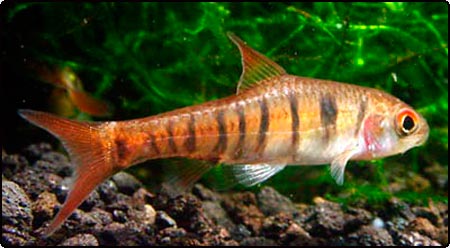African Banded Barb
Angola barbel ( Barbus fasciolatus )
The Angola barbel ( Barbus fasciolatus; Synonyms: Barbus bariloides, Boulenger, 1914), also blue line Barbe, Rotflankenbarbe or Tiger bar called, comes in southern Africa in the Kunene, Okavango, the upper and middle Zambezi, the Kafue, the upper Congo basin ( Luongo, Luapula ), before the Bangweulusümpfen and in the Kariba Dam.
Features
The Angola bar is 5 to 7 cm long and has a generic typical elongated, laterally flattened shape. Females are much stronger, leaner males. Your back is brownish to gray- green, the sides of the body are patterned orange to reddish and with 12 to 16 narrow, dark stripes. The Style epithet fasciolatus means finely striated. The third and the last may be widened to form a spot. The belly is whitish, the fins are yellowish, the dorsal fin is wearing a crimson stain. Young females are often tintenrot. The caudal fin is forked. Your sideline is complete. The Angola Barbe has two equally long Bartel pairs.
- Fins formula: Dorsal 3/8, Anal 3/5.
- Dandruff formula: 28-30 (MLR )
Way of life
It inhabits oxygen-rich, well- vegetated waters and is shy. Their main activity time is early morning and late afternoon. The Angola Barbe feeds on worms, crustaceans, insects and plant material. During spawning, the females give from 150 to 200 eggs. The fry hatch depending on the temperature after about 50 hours, swim freely after an additional 3 to 4 days and can be grown in just 6 months.










